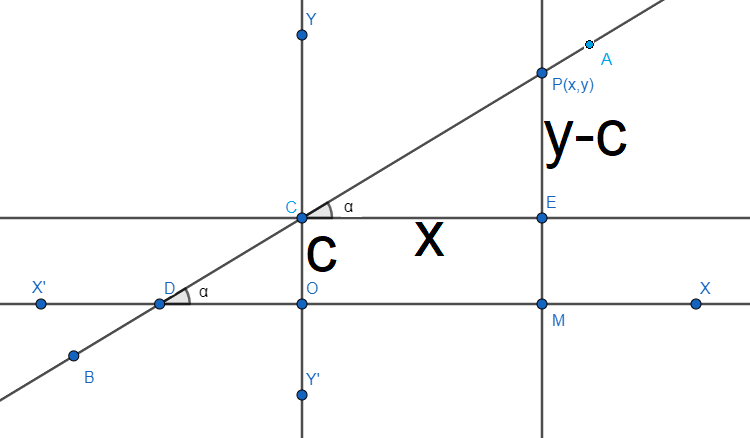
How do you write an equation in slope intercept form given two points?
Answer
550.2k+ views
Hint: We first find the slope-intercept form for any point $P\left( x,y \right)$ and also find the equation of the line. In this case we actually take the help of the origin where $O\left( 0,0 \right)$. Then we take two arbitrary points and place them on the equation of the line and find the value of the slope and its equation.
Complete step-by-step solution:
We need to find the equation of the line which is inclined at a given angle with the positive direction of the axis of x and cuts off a given intercept from the axis of y.
Suppose the line $\overleftrightarrow{AB}$ intersects the X-axis at D and the y-axis at C. if the line makes an angle $\alpha $ with the positive direction of X-axis and $\overleftrightarrow{OC}=c$. We have to find the equation of the line $\overleftrightarrow{AB}$.

Let $P\left( x,y \right)$ be any point on the line $\overleftrightarrow{AB}$. We draw perpendicular $\overleftrightarrow{PM}$ on $\overleftrightarrow{OX}$ and $\overleftrightarrow{CE}$ perpendicular on $\overleftrightarrow{PM}$. Since, $CE||DM$, we have $\angle PCE=\angle CDM=\alpha $.
We also have $\overleftrightarrow{PM}=y;\overleftrightarrow{OC}=c;\overleftrightarrow{CE}=\overleftrightarrow{OM}=x$.
Then we have $\overleftrightarrow{PE}=\overleftrightarrow{PM}-\overleftrightarrow{EM}=\overleftrightarrow{PM}-\overleftrightarrow{OC}=y-c$.
Therefore, from the right-angled $\Delta PCE$, we get $\tan \alpha =\dfrac{\overleftrightarrow{PE}}{\overleftrightarrow{CE}}=\dfrac{y-c}{x}$.
We assume that the slope is m where $m=\tan \alpha $ which gives $m=\tan \alpha =\dfrac{y-c}{x}$.
The equation becomes $y=mx+c$.
Now if two points are given of the line where $P\left( x,y \right)$ and $Q\left( {{x}_{1}},{{y}_{1}} \right)$, the only change happens in the slope. For the above problem we took the second point as the origin.
Now both $P\left( x,y \right)$ and $Q\left( {{x}_{1}},{{y}_{1}} \right)$ goes through $y=mx+c$.
This gives $y=mx+c$ and ${{y}_{1}}=m{{x}_{1}}+c$. Subtracting we get $y-{{y}_{1}}=mx-m{{x}_{1}}=m\left( x-{{x}_{1}} \right)$.
The value of m becomes $m=\dfrac{\left( y-{{y}_{1}} \right)}{\left( x-{{x}_{1}} \right)}$. The equation becomes $\left( y-{{y}_{1}} \right)=m\left( x-{{x}_{1}} \right)$.
Note: We could have used the same process where we replace the origin value $O\left( 0,0 \right)$ with the point $Q\left( {{x}_{1}},{{y}_{1}} \right)$. The shifting of the origin will be sufficed to do that.
Complete step-by-step solution:
We need to find the equation of the line which is inclined at a given angle with the positive direction of the axis of x and cuts off a given intercept from the axis of y.
Suppose the line $\overleftrightarrow{AB}$ intersects the X-axis at D and the y-axis at C. if the line makes an angle $\alpha $ with the positive direction of X-axis and $\overleftrightarrow{OC}=c$. We have to find the equation of the line $\overleftrightarrow{AB}$.

Let $P\left( x,y \right)$ be any point on the line $\overleftrightarrow{AB}$. We draw perpendicular $\overleftrightarrow{PM}$ on $\overleftrightarrow{OX}$ and $\overleftrightarrow{CE}$ perpendicular on $\overleftrightarrow{PM}$. Since, $CE||DM$, we have $\angle PCE=\angle CDM=\alpha $.
We also have $\overleftrightarrow{PM}=y;\overleftrightarrow{OC}=c;\overleftrightarrow{CE}=\overleftrightarrow{OM}=x$.
Then we have $\overleftrightarrow{PE}=\overleftrightarrow{PM}-\overleftrightarrow{EM}=\overleftrightarrow{PM}-\overleftrightarrow{OC}=y-c$.
Therefore, from the right-angled $\Delta PCE$, we get $\tan \alpha =\dfrac{\overleftrightarrow{PE}}{\overleftrightarrow{CE}}=\dfrac{y-c}{x}$.
We assume that the slope is m where $m=\tan \alpha $ which gives $m=\tan \alpha =\dfrac{y-c}{x}$.
The equation becomes $y=mx+c$.
Now if two points are given of the line where $P\left( x,y \right)$ and $Q\left( {{x}_{1}},{{y}_{1}} \right)$, the only change happens in the slope. For the above problem we took the second point as the origin.
Now both $P\left( x,y \right)$ and $Q\left( {{x}_{1}},{{y}_{1}} \right)$ goes through $y=mx+c$.
This gives $y=mx+c$ and ${{y}_{1}}=m{{x}_{1}}+c$. Subtracting we get $y-{{y}_{1}}=mx-m{{x}_{1}}=m\left( x-{{x}_{1}} \right)$.
The value of m becomes $m=\dfrac{\left( y-{{y}_{1}} \right)}{\left( x-{{x}_{1}} \right)}$. The equation becomes $\left( y-{{y}_{1}} \right)=m\left( x-{{x}_{1}} \right)$.
Note: We could have used the same process where we replace the origin value $O\left( 0,0 \right)$ with the point $Q\left( {{x}_{1}},{{y}_{1}} \right)$. The shifting of the origin will be sufficed to do that.
Recently Updated Pages
Why are manures considered better than fertilizers class 11 biology CBSE

Find the coordinates of the midpoint of the line segment class 11 maths CBSE

Distinguish between static friction limiting friction class 11 physics CBSE

The Chairman of the constituent Assembly was A Jawaharlal class 11 social science CBSE

The first National Commission on Labour NCL submitted class 11 social science CBSE

Number of all subshell of n + l 7 is A 4 B 5 C 6 D class 11 chemistry CBSE

Trending doubts
What is meant by exothermic and endothermic reactions class 11 chemistry CBSE

10 examples of friction in our daily life

One Metric ton is equal to kg A 10000 B 1000 C 100 class 11 physics CBSE

1 Quintal is equal to a 110 kg b 10 kg c 100kg d 1000 class 11 physics CBSE

Difference Between Prokaryotic Cells and Eukaryotic Cells

What are Quantum numbers Explain the quantum number class 11 chemistry CBSE




